💡[Case Study] Lenskart’s Strategy that Changed Indian Eyewear Industry Forever
[10 min read] Learn how Lenskart beat Reliance and Tata, one strategy at a time. Here’s a deep dive that you just can’t miss! ReadOn👇🏼
One word: Lenskart.
Vision of the company?
To bring ‘Vision to India'.
According to WHO, only one-third of the 100 million Indians who need a pair of spectacles have access to it.
Lenskart set out to change this.
And today, it has become a household name, with stores covering about 313 cities in the country.
The Indian eyewear market went from generating a revenue of $3.17 billion in 2014 to an estimated revenue of $6.10 billion in 2024. The market is set to grow at a 7.54% CAGR between 2024 and 2028.
While about 80% of this market is dominated by unorganised players, Lenskart captures around 41% share in the organized eyewear market.
It has even beaten giants like Tata's Titan and Reliance's Vision Express!
In this piece we will discuss:
Eyewear problems before Lenskart
The supply chain problem solved by Lenskart
The real hero of the eyewear industry revolution
What are other eyewear players doing?
Is the Lenskart model easy to replicate?
The future of eyewear industry
Lenskart Came, Saw & Conquered
Before the arrival of Lenskart in 2010, the Indian eyewear market was flooded with:
mediocre quality products,
limited design options, and
unorganised players offering no guarantees and no warranties.
Amongst all these deficiencies, three things were high in this market:
the lead time for deliveries,
the margin of error in the end products and
the cost of products to consumers.
Lenskart simply tried to solve these real customer problems:
Robotic automated eye-testing: Remember how it would take days to adjust into your new pair of glasses only to later realise that the power in the eyeglasses does not match the power in your eyes? Where traditional eyewear shops could not guarantee a 100% accuracy, Lenskart brought in best-in-class robotic technologies from Germany, offering zero error tolerance.
Virtual try-ons, easy returns: Remember when buying clothes without knowing how they would look on you seemed ridiculous? Then came the e-commerce boom that eased you into buying them online without any trial with features such as easy returns and exchanges.
But hey, specs are not socks. You would not buy a pair to match all your outfits. So when it came to buying eyewear, you had to be absolutely sure that they suit you.
To solve these user apprehensions without which online shopping of eyewear would be a dream, Lenskart came up with a brilliant use of augmented reality (AR) technologies to enable virtual 3D try-ons for its customers.
At-home and in-store eye checkups: A doctor’s visit was almost mandatory every time you needed to check your eye power. Lenskart realised the acute shortage of optometrists in the country and it started to offer at-home eye checkups by trained optometrists. Not shortly after, it became apparent that there were many people who could not even afford eye-check ups. Lenskart offered free in-store eye checkups, truly making vision correction much more accessible in India.
Good quality at affordable prices: One of the biggest problems in the Indian eyewear market was that eyewear prices were at extreme ends. Either you could opt for cheaper products with low quality or you had to spend a bomb for the good quality glasses. Only a very few could afford to opt for the high quality, high price products considering the need to often change eyeglasses due to a change in the power.
Lenskart identified a gap in the market where no one was selling good quality products in a mid-range segment that made customers say “paisa vasool!” It eliminated intermediaries in the supply chain and started to offer products at highly competitive prices.
Rapid delivery: Most e-commerce businesses had to compete with the instant gratification of offline purchases with a considerable time for delivery in online shopping. But where customers had to wait for 6-7 days to get delivery of glasses purchased at retail stores, Lenskart was offering a 72-hour delivery.
Hassle free returns: Most products that one would purchase online could be easily sold to other customers if returned. However, that does not hold true with spectacles which are customised for each user. But Lenskart was offering a 14-day no questions asked return policy, to help the users find ease in online eyewear shopping.
The Eyewear Industry Supply Chain
Like many other consumer products, eyeglasses were also predominantly imported from China. Following a traditional supply chain mechanism made eyeglasses an expensive affair.
How was the traditional supply chain structured?
Glasses were primarily imported from China by importers which then changed hands from distributors to retailers before reaching the end customer. At each leg of the supply chain, each intermediary kept a slice of the pie for themselves, increasing the cost of the product to the end customer.
What did Lenskart do when it entered the market?
They did what typically all e-commerce players were doing at that time. They became the sole middleman between the manufacturer and the customer, eliminating the importers, distributors and retailers of the supply chain. In doing so, they also eliminated the excess margins at each step of the chain.
How did Lenskart gain competitive advantage with a lean supply chain?
Affordable pricing by eliminating intermediary costs.
Design and quality were much more in Lenskart’s control owing to its direct relation with manufacturers.
Reduced lead time as products were directly sourced from manufacturers.
Ease of business by eliminating middlemen helped Lenskart deal with hassles of collections, unsold inventories and write-offs that grappled the traditional supply chain.
The Real Hero of the Eyewear Industry Revolution: Tech
What technologies, you ask?
Let’s go through some of the most significant technological advancements in the eyewear industry.
Manufacturing: went from a laborious and heavy machinery reliant process to a computer-aided and automated process. As a result, higher quality products are produced with higher efficiency in lesser time.
Features: Lenskart, through its continuous research, development and innovation began offering lighter glasses with more features such as anti-glare glasses and blue light filtering lenses.
Automated testing: The accuracy of diagnosis in vision correction was not an easy problem to solve.By using zero error machinery and enabling at-home eye tests by trained optometrists, customers could now get their prescription without even stepping out of their homes.
Virtual try-ons: The use of cameras on smartphones and augmented reality (AR) helped solve the trial-before-purchase. Customers could simply upload a selfie and get recommendations based on size and style. They could even try on the glasses virtually from the comfort of their homes!
AI and machine learning: AI and ML provide personalised recommendations to customers to complement their facial features.
Other Players in the Eyewear Market
So, is Lenskart the “gunda” of the eyewear market?
Maybe, but it is not without a fight.
The lure and potential of India’s growing eyewear industry is lucrative and with about 80% of the market still unorganised, there is plenty of fish in the sea for everyone.
In fact, when Lenskart began its operations in 2010, it wasn't the only player.
There was already one player that was rapidly growing in the retail market. It had the backing of one of the most renowned and trusted brands in India – the Tatas.
Yes, we're talking about Titan Eyeplus, which was already 200 showrooms strong in 2011.
But today, Lenskart’s market share is 5 times that of all of Titan’s Eyewear brands like Titan Eyeplus and Fastrack put together.
When Tata is in the play, how can Ambani be far behind!
While Tatas were opening Titan Eyeplus stores across the country, Reliance entered into a joint venture with Europe’s Grand Vision opening a chain of Vision Express stores in the retail markets.
So how did Lenskart manage to surpass these companies with deep pockets and established brands in becoming a household name for eyewear?
Lenskart realised very early on in the game that while its D2C proposition is great, the eyewear industry cannot go completely online.
It adopted an omni-channel strategy.
Yes, while most D2C brands are now moving from an online-only to an omni-channel presence, Lenskart did this on day 1.
Not just legacy brands like Tata and Reliance, today the eyewear market has a number of new age D2C players like Specsmakers, Cool Winks, Eye My Eye and ClearDekho, walking on a path paved by Lenskart.
Lenskart, in FY23, was way ahead of its competition not only in terms of market share but also in terms of revenue. Where Lenskart reported a revenue of 3,780 crore rupees in FY23, Titan’s eyewear segment reported a revenue of 689 crore rupees.
Not just in revenue, Lenskart has an upper hand even in its physical presence across the country, having over 1300 stores across 313 cities in India, 1.5 times the number of Titan Eyewear stores in India.
While Lenskart is clearly winning the volume game, it reported a profit of approximately 6.8% against its revenue in FY23 (amounting to Rs. 260 crore) recovering from a Rs. 100 crore loss reported in FY22.
Titan Eyewear, on the other hand, earned a profit at about 14.2% (amounting to 98 crore rupees).
While information on profitability of other players is not publicly available, it would be interesting to see whether Lenskart can make money and still stay at the top.
Is Lenskart’s Model Easy to Replicate?
There is no denying that Lenskart did bring a brilliant vision into the India eyewear industry that forced even the biggies like Titan and Reliance to start offering online shopping experience to consumers.
The success of Lenskart did, undoubtedly, inspire many other D2C players into the market.
But this brings us to the question: while Lenskart is reaping the fruits of first mover advantage, has the Lenskart model now become easy to replicate?
The barrier of entry is easing with the increase in access to institutional capital and Lenskart has already done the back breaking work of getting the market accustomed to ease of online purchase of eyewear.
Today, all the major players in the market offer the same technological innovations and value propositions offered by Lenskart – be it virtual try-ons or affordable products or at-home eye testing.
Will Lenskart manage to retain or widen the gap between itself and its competitors or is it a matter of time before they catch up?
Well, even today, there are a few things that set Lenskart apart from its competition.
One of the biggest cards in Lenskart’s favor is its manufacturing setup. Over its time in the industry, Lenskart realised that to deliver true value to customers, it must have better control over production. Today, it operates the world’s largest automated eyewear manufacturing facility in India. Its vertical integration has enabled it to not just reduce its reliance on imports, but also to effectively manage turnaround times and inventory across the supply chain.
Second, Lenskart has exhibited great strength in its innovative solutions solving real consumer problems. One such example involves showcasing the true essence of its omni-channel presence by offering a pick-up-from-store service, wherein, the customers would select and order from the online store and pick up the ready product from the nearest store after trying it in person and being fully satisfied with the fit.
Future of Eyewear Industry
Like any other industry, the eyewear industry is bound to get more competitive and saturated with time, but the future of the industry’s favor will lie in continuous innovation.
Even today, there is a huge section of the market that remains unorganised and a consumer segment in Tier 2 and Tier 3 India is still untapped.
New and emerging companies, like ClearDekho are targeting these untapped markets and mining for exponential value.
While Lenskart is expanding its presence in the global market, Google and Apple are taking technological advancements and innovations to new heights by developing smart eyewear. With a combination of augmented reality, advanced computer vision and artificial intelligence, the end product could end up replacing our omnipresent smartphones.
As the market grows and evolves, the customer-centric approach and ability to innovate and demonstrate agility will determine the success of eyewear brands in the industry.
What would be key to note would be whether the businesses will grow with the support of hefty discounts and cash burns or whether sustainable, profitable businesses can emerge as competition increases.
Liked the piece? Share it!



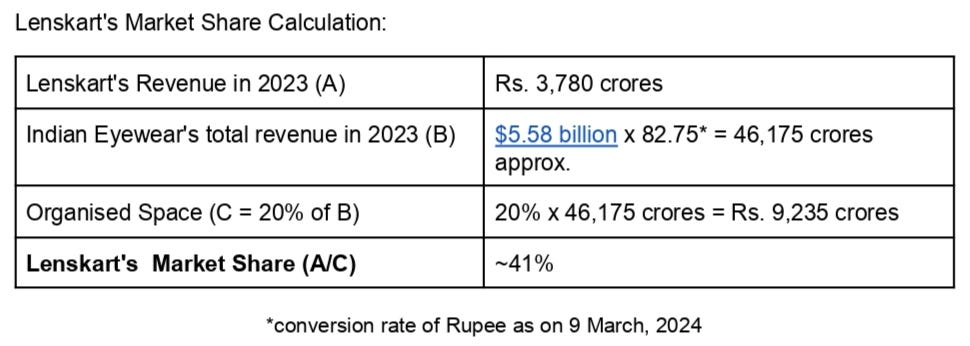
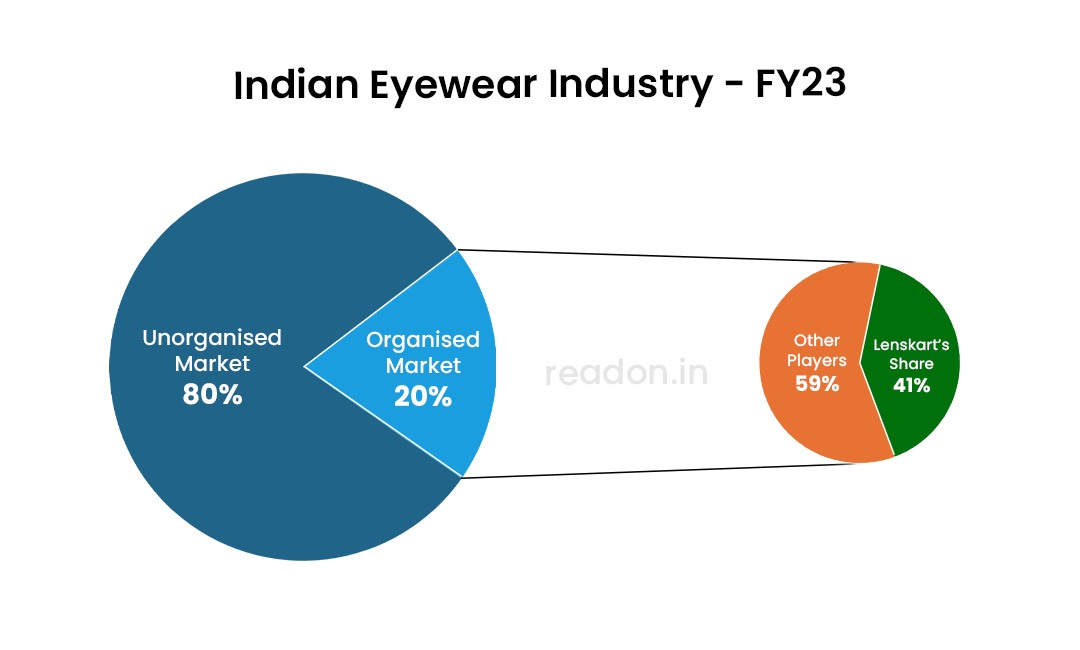

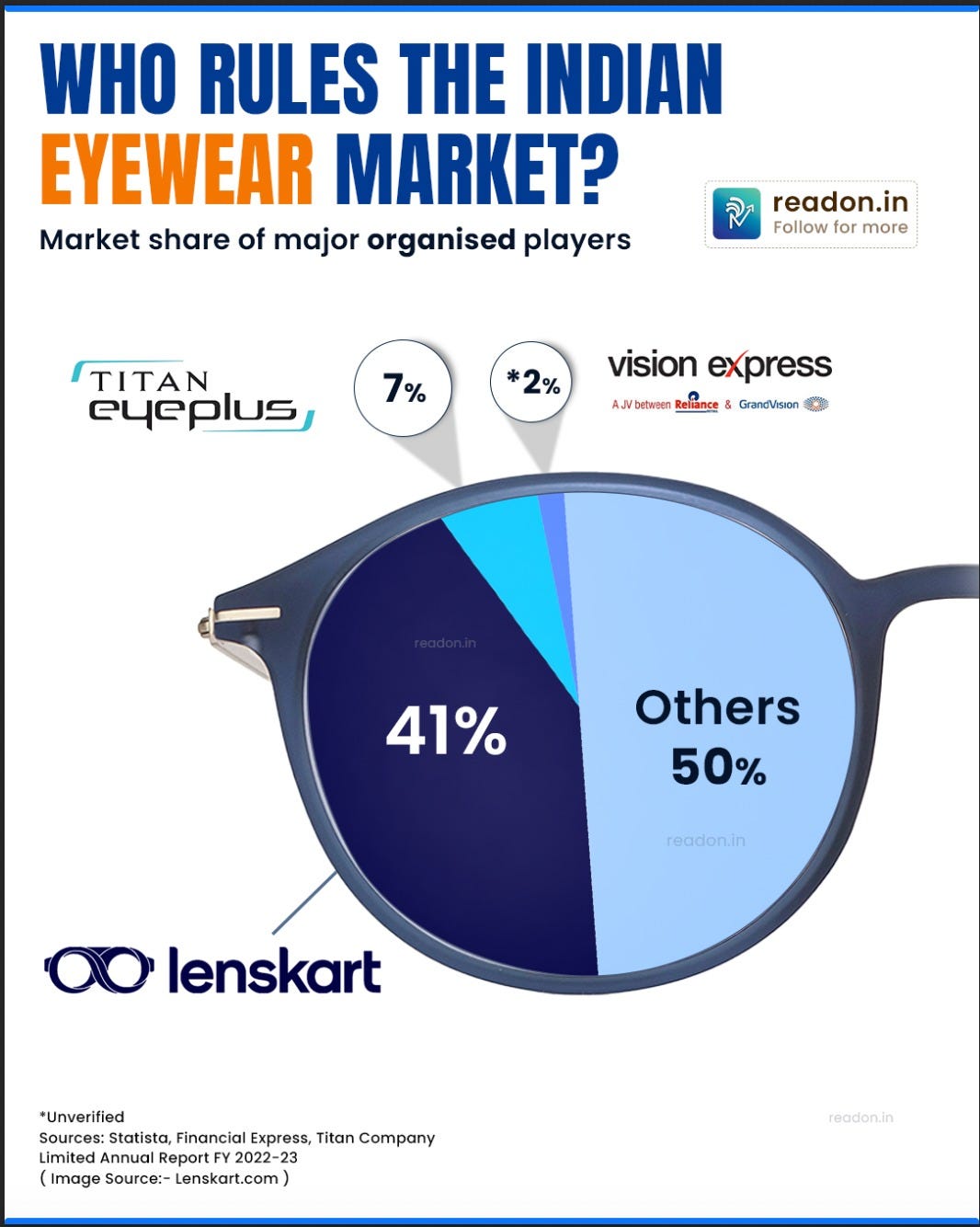
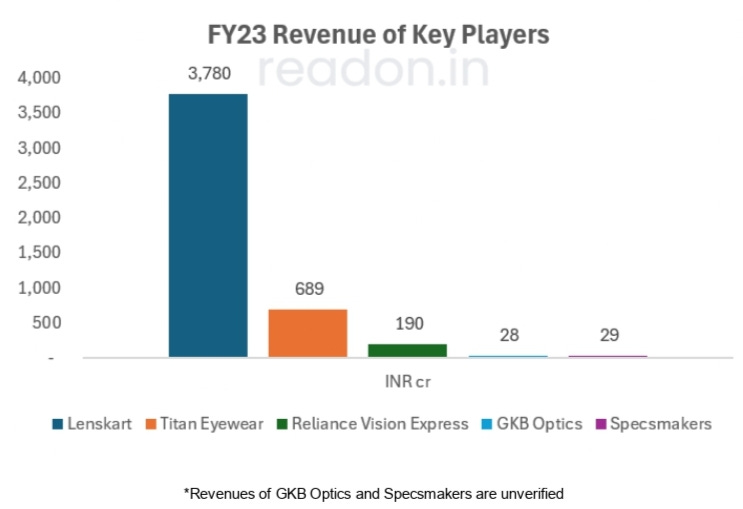
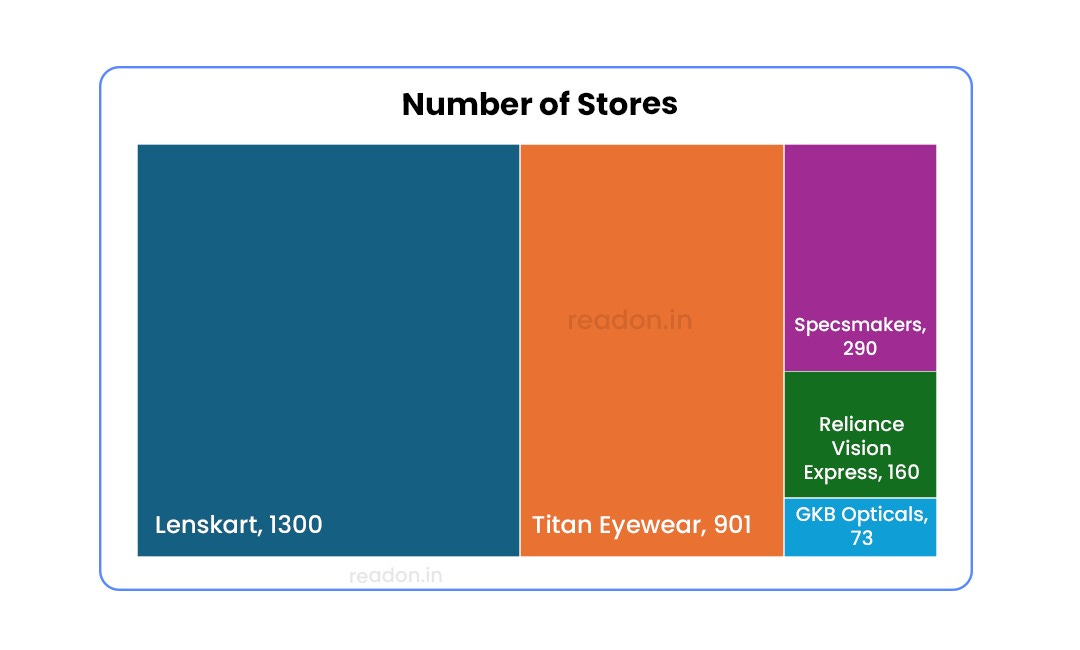
Nice work 👏 👌
Some info are wrong here,I was the lenskart employee ,lenskart provide local lens under the brand of lenskart ,except rodensrock and Od,but every spectacle lens of titan are genuine and FDA approved,another example lenskart hustlar frame you buy under 2000 in 2,where sake qwality distract frame single price 800 rs and buy to @1280,lenskart cheated us via their solid marketing,titan gives doing poor bussines.